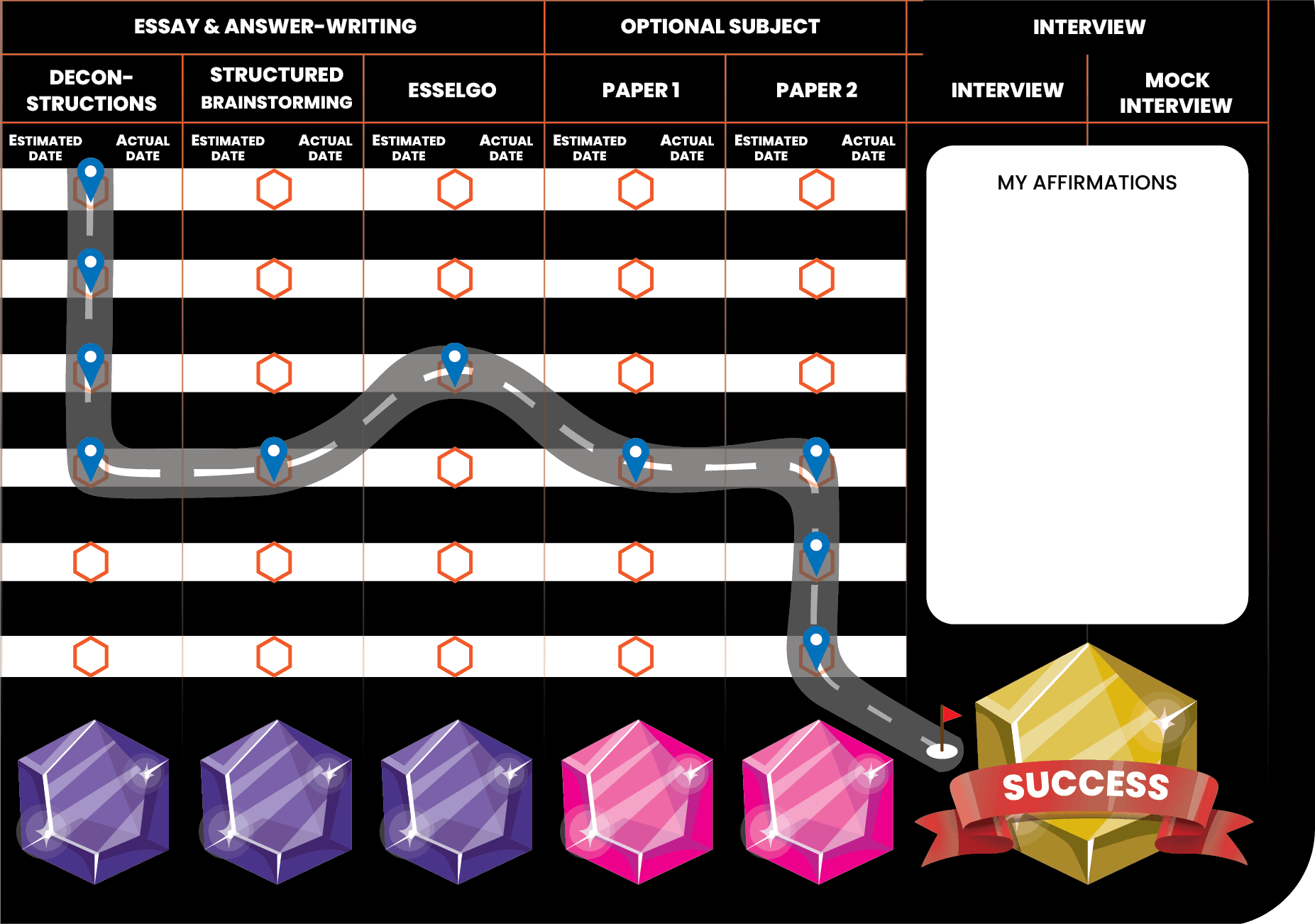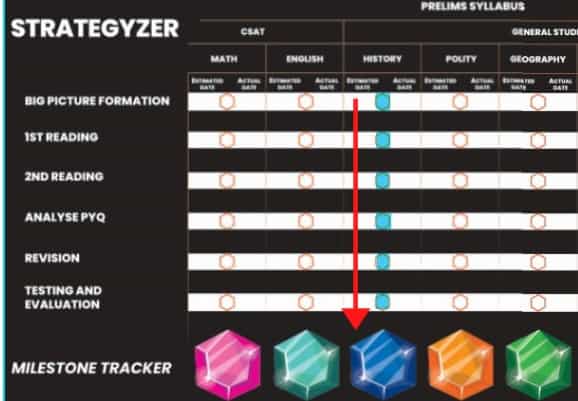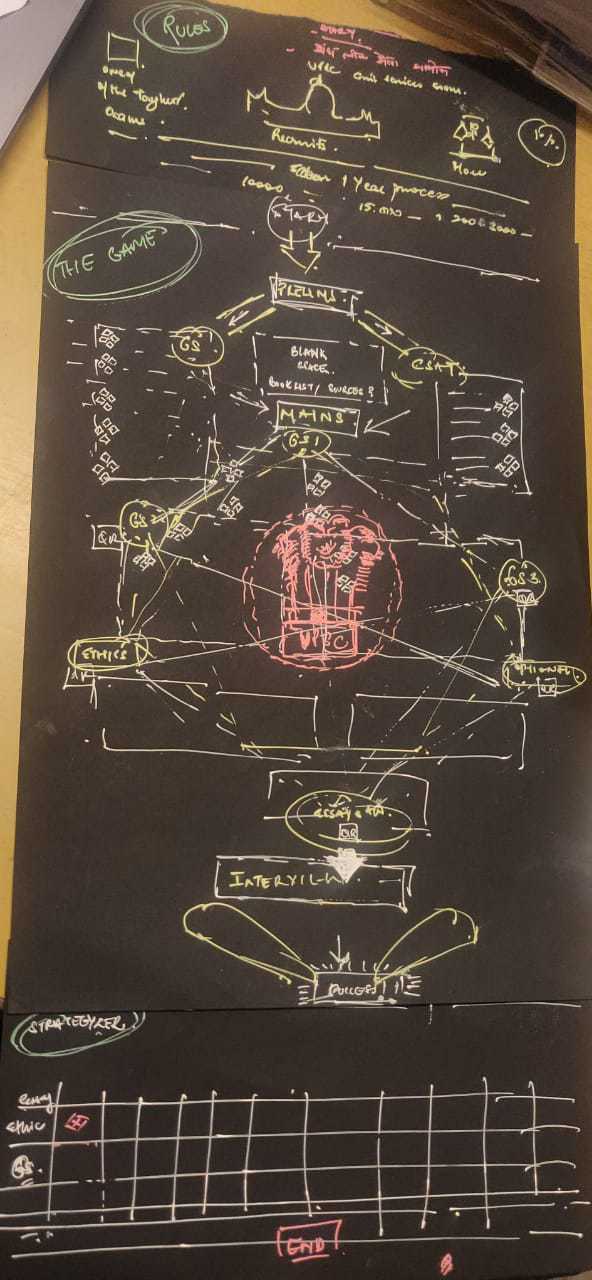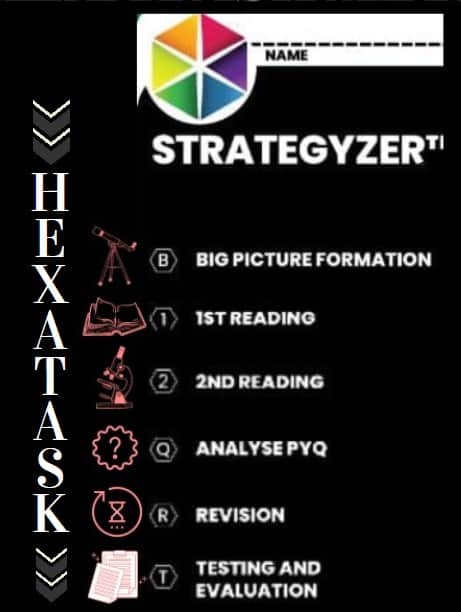
The seemingly never-ending UPSC syllabus can overwhelm even the most devoted of aspirants. It appears to be indomitable because most aspirants do not approach it with a good strategy. Or with any strategy at all.
A timetable or a to-do list of your goals is NOT a strategy. It is a wish-list. A strategy consists of extensive actionable micro-goals scaffolded by accountability measures that keep you on track for your ultimate goal.
The Strategyzer in the Ultimate UPSC Navigator is designed scientifically such that all the ingredients are embedded and in-built.
Strategy = Measurable Micro-goals + Tracking system + Accountability & discipline-inducing mechanisms + Quality-check + Customized to individual strengths and weaknesses + Roadmap
THE ULTIMATE UPSC STRATEGY: TOP5 PROTOCOL
The Ultimate strategy for the UPSC exam has been distilled from the strategy of not one, but many toppers over the years. Time and time again, the same fundamental guidelines emerged with discussions with many UPSC toppers and successful candidates. These insights were combined with research from the behavioral sciences, cognitive sciences, goal-setting theory, and motivation studies to create the Ultimate Strategy- the TOP5 PROTOCOL.
TOP5 PROTOCOL consists of universal strategic guidelines from many toppers.

STRATEGYZER: The scheduler and planning tool at the bottom of the UPSC Navigator. A matrix of deadlines and targets where you can track your entire UPSC preparation. A redesigned Gantt Chart, is a Karmic scheduler, milestone tracker and will serve as a constant reminder of your promises. Ignore it at your own peril.
Toppers Strategy 1: Define Micro-Goals
For UPSC preparation/General Studies, simply breaking it into Subject-domains like history, geography etc is not enough. To truly cover the syllabus well, you must know that what gets measured gets done. You must break the entire syllabus into concrete-actionable goals which are achievable within a few days each. This insight parallels Goal setting theory which states that motivation remains maximum when goals are small, challenging, and achievable.
All toppers claim to have used extensive goal setting in their preparation. They make sure to stay systematic and consistent all thought he UPSC journey.
What is the Strategyzer? The scheduler and planning tool at the bottom of the UPSC Navigator. A matrix of deadlines and targets where you can plan and track your entire UPSC preparation. A redesigned Gantt Chart, it is a Karmic checklist, milestone tracker and will serve as a constant reminder of your promises. Ignore it at your own peril.
The Strategyzer breaks the entire UPSC syllabus scientifically into 102 micro-goals. All the 102 micro-tasks are of roughly equivalent difficulty and time duration. They are structured to build your preparation from ground-up.
Caveat: Some micro-tasks may take longer than others to complete. This is normal and to be expected and doesn’t change the calculation because the overall time consumed in conquering the various micro-tasks to reach the bigger milestones will average out.
The way they are arranged one on top of the other is designed to follow closely the TOP5 protocol such that the quality of learning remains uncompromised all through the preparation.
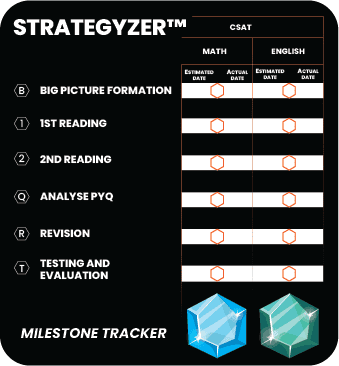
The UPSC Navigator is a powerful tool created for serious UPSC Aspirants who need everything in 1 place. It is intended to be used long-term and contains thousands of pages worth of notes (subject-wise) in the QR codes. It can be found here.
Toppers Strategy 2: Build A Roadmap With Milestones
A roadmap is a bigger picture of all your micro-goals and how they are tied together – with milestones included. A Roadmap is a representation of your intended journey through the maze of UPSC syllabus. Remember that it is a journey which will last months.
Winning Small battles lead to big victories, and they should be celebrated. The milestone tracker is the series of Hexa-gems at the bottom of the Strategyzer representing your thorough completion of each major portion of the UPSC exam.
A smart roadmap contains strategically placed milestones to mark progress. Milestones are meant to remind you how far you have come in your journey and the distance remaining.
IAS toppers spend time analysing and forming their unique roadmap of preparation. They have feedback mechanisms to understand their progress.
The Milestone tracker in the Ultimate UPSC Navigator does exactly that subject-wise by using color-coded Hexa-gems. Each hexa-gem represents the main subjects in the UPSC syllabus and the combined knowledge of the subject as required for the UPSC exam.
For instance, to complete your preparation for History, you must obtain the Blue Hexa-gem, you would have to capture the 6 hexa-tasks of History one by one.
This means that only after you have gone through big picture formation, 1st reading, 2nd reading, Analyzed PYQs, Revised, and Tested yourself, can you claim to have ‘done’ History for the UPSC exam. (See Hexatask Method)
Your job as a UPSC aspirant is to obtain all the Hexa-gems, at the end of which the Ultimate gem awaits- success.
You can build a customized preparation roadmap using the Strategyzer which can be molded and adjusted as per requirement.
Milestone tracker- Winning Small battles lead to big victories and they should be celebrated. The milestone tracker is the series of Hexa-gems at the bottom of the Strategyzer representing your thorough completion of each major portion of the UPSC exam. More info about the Strategyzer is here.
Toppers Strategy 3: Establish Accountability Mechanisms
The difference between a wish-list and a concrete strategy is being able to stay on track.
UPSC toppers know that that being human means being prone to indiscipline, laziness and procrastination. Accountability measures ensure that you stay disciplined and on track to your long-term goals.
All Toppers recommend a form of discipline formation. These can be mentors or teachers which nudge you towards your goal. But fortune favours those who help themselves.
You must use the insights from psychology and cognitive science to keep yourself on track and discipline. These principals are an integral part of the Ultimate UPSC Navigator.
To do this, the Ultimate UPSC Navigator used the phenomenon of Cognitive dissonance and Reinforcement learning to induce habit-formation so that you are least likely to procrastinate and get off-track.
The Ultimate UPSC Strategyzer forces you to commit to dates and deadlines. Research from the field of Cognitive Science confirms that merely having regular exposure to your goals and commitments increases the likelihood of compliance and discipline manifold.
MICROHEXES are the tiny hexagons in the Strategyzer which denote all the micro-tasks you must perform to prepare yourself thoroughly for the UPSC exam. These are your Baby-steps for conquering your biggest dreams.
These micro-targets will forever be in front of you on the UPSC Navigator, reminding you of your commitments. Breaking these will produce dissonance and guilt and make it more likely that you will stay on track for longer and more often. Over time, it will form into an automatic habit and UPSC preparation will seem enjoyable and effortless to you.
MICROHEX: The tiny hexagons in the Strategyzer which denote all the micro-tasks you must perform to prepare yourself thoroughly for the UPSC exam. These are your Baby-steps for conquering your biggest dreams.
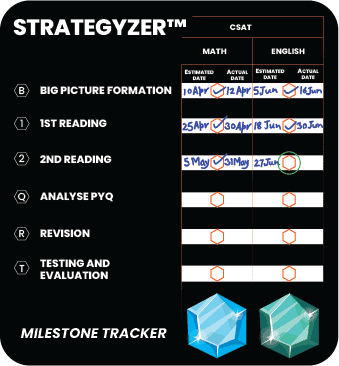
The Strategyzer will force you to commit the estimated date of completion of your micro-goals. When you achieve them, you will record the actual date of completion and note if you are keeping close to your targets.
Toppers Strategy 4: Customize And Adapt
A good strategy is a dynamic strategy i.e., it is adaptable to changing plans. It is a given that you will not be able to follow the roadmap in the Strategyzer perfectly. You may take longer in some micro-goals than anticipated and may have to re-adjust your goals. The UPSC Navigator takes this into account and actually prepares you for it.
IAS toppers remain adaptable and shift their strategy when they need to. They become comfortable with uncertainty and mouldability.
A good strategy is also one which is customized to your needs. You have a different knowledge base, mindset, learning style, strengths and weaknesses from other aspirants. Needless to say, your preparation strategy should be geared accordingly.
GS is common to all rounds and preparation should be undertaken as an integrated whole. The design of the Ultimate UPSC Navigator is inspired by the insight that the UPSC exam flows sequentially from one round to the next (Prelims->Mains->Interview) and yet remains highly dynamic and inter-twined. Much like Pinball- a highly dynamic game.
Like Pinball, your paths to the goal will be completely unique. The Strategyzer allows for near infinite roadmaps for UPSC preparation depending on your strengths, weaknesses, preferences and chosen plan of action.
Your strategy may be organised according to individual subjects like Polity, optional subject, History. You may choose to target Prelims first and relegate Optional subjects to later. Or you may wish to finish CSAT before you do GS- it can all be done with the UPSC Navigator. Whichever path you choose, you will always end up in closure after going through the 3 rounds of elimination of the UPSC Exam where finally, success will be found. This essence is captured by the Navigator’s design.

Pinball is a game in which you propel a ball onto an obstacle board where randomness can cause the ball to strike anywhere bouncing off the board in unpredictably. But it always ends up at the bottom. You are much like the pinball during your UPSC journey.
An earlier draft sketch of the Ultimate UPSC Navigator
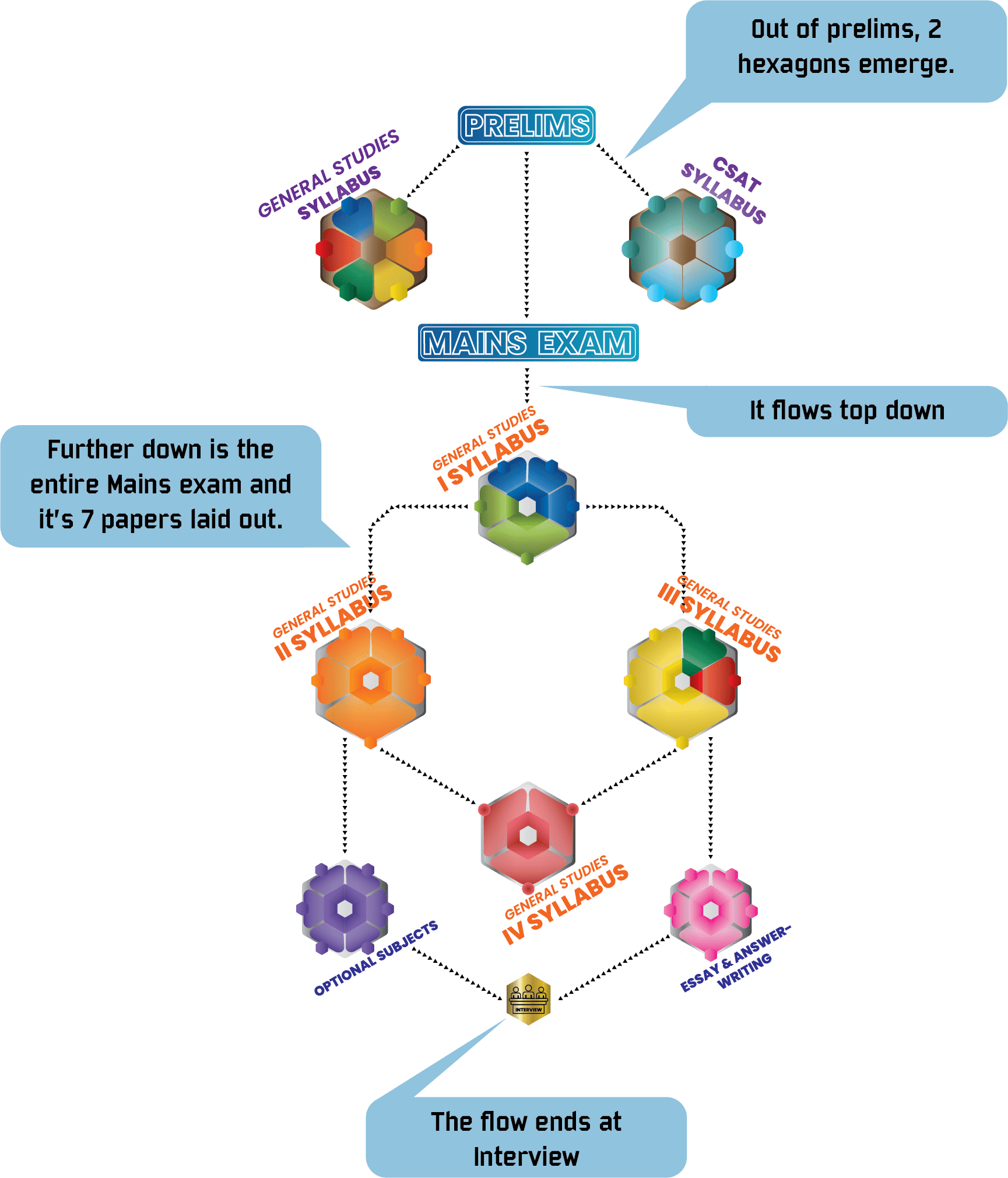
The top-down but dynamic flow of the UPSC Navigator mirroring the UPSC exam pattern.
Toppers Strategy 5: Quality-Check Your Learning
The UPSC demands a sophisticated understanding of many topics. The questions in UPSC Prelims can be highly detailed and difficult to answer with certainty. Likewise, the questions in Mains can be highly analytical and broad-based. Both require you to be thorough with the study material and have all the information deeply understood-factually and conceptually.
How do toppers make sure they have achieved mastery over a topic? They do a series of tasks for every subject so that all aspects of the topic are covered thoroughly.
They from a big picture of the content, do multiple readings, test themselves rigorously, analyse previous year questions and revise intelligently.
All these have been distilled from the study strategies of many toppers and codified formally into the HEXATASK Method.
HEXATASK: The 6 steps which you must perform like rituals to claim that a subject or a topic is truly ‘done’ for the UPSC exam. Without the ritual, the ceremony which you must perform to appease the Goddess of knowledge, remains unfinished.
The Hexatask method is a series of 6 steps which takes you through all the dimensions of learning to cover for the UPSC Exam. These stages mirror the stages of Information Processing from the Cognitive Sciences wherefrom research tells us that deeper and deeper encoding coupled with repetition is the absolute best way to learn.
So, without having done all Hexatask for a subject, even though you might feel confident about a subject, you are probably not well prepared enough to be truly competitive for this exam.
Disclaimer
While we strive to provide you with updated information, please go through the latest official exam notification to check the detailed eligibility criteria for the specific exam year to avoid any confusion
THE ULTIMATE UPSC NAVIGATOR CAN BE FOUND HERE
REVIEWS OF THE UPSC NAVIGATOR FROM USERS ARE HERE


